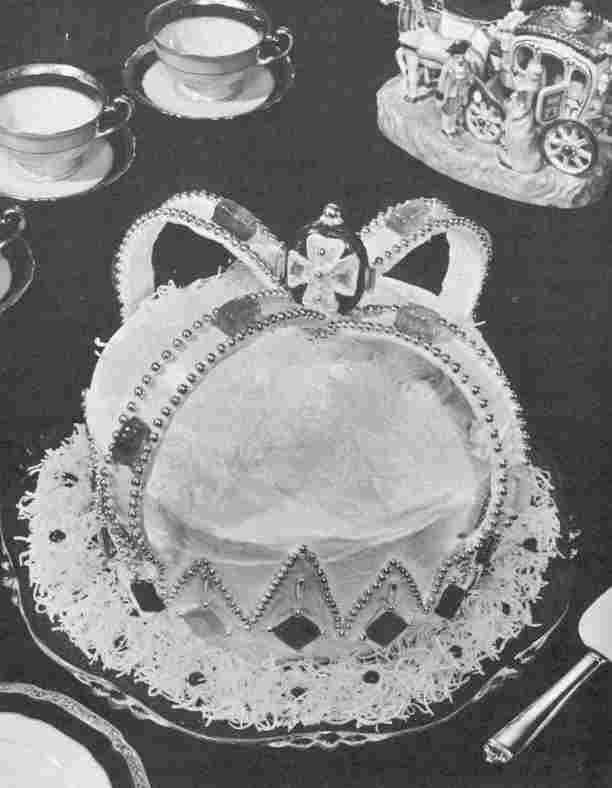Catholic Recipe: Crown Cake
INGREDIENTS
- 3 cups cake flour, sifted
- 2 teaspoons double-acting baking powder
- 1 1/2 teaspoons salt
- 1 3/4 cups sugar
- 1 cup shortening or butter (softened)
- 1/2-3/4 cup milk*
- 3/4 teaspoon orange extract (or 1 Tbsp. orange zest)
- 3/4 teaspoon almond extract
- 3 eggs
- 1 egg yolk
- Seven Minute Frosting (see recipe), 1-1/2 recipes
Supplies
- 9" tube pan, greased and floured
- Thin yellow cardboard, 20 inches long
- yellow food coloring
- Silver dragées, both large and small sizes
- square, clear, bright-colored candy resembling jewels
- flat red lollypop
- shredded coconut
- chocolate chips
Details
Serves: 10
Yield: 1 9-inch cake
Prep Time: 3 hours
Difficulty: ★★★☆
Cost: ★★★☆
For Ages: 11+
Origin:
showFood Categories (2)
showOften Made With (1)
showLinked Activities (11)
- Baptism Customs
- Day Twelve ~ Activities for the Twelfth Day of Christmas
- Nameday Ideas for St. Agatha, Virgin and Martyr
- Nameday Ideas for the Feast of St. Barbara, Virgin and Martyr
- Nameday Ideas for the Feast of St. Cecilia, Virgin and Martyr
- Nameday Ideas for the Feast of St. Elizabeth of Hungary
- Nameday Ideas for the Feast of St. Margaret of Scotland
- Nameday Prayers and Ideas for St. Paul the Apostle
- Namedays
- What is a Nameday?
- Nameday Ideas for the Solemnity of the Immaculate Conception
showFeasts (10)
- Conversion of St. Paul the Apostle
- Thomas Aquinas
- JOSEPH, SPOUSE OF MARY
- First Martyrs of the Holy Roman Church
- Queenship of Mary
- Margaret of Scotland; Gertrude
- Elizabeth of Hungary
- Cecilia
- OUR LORD JESUS CHRIST, KING OF THE UNIVERSE
- IMMACULATE CONCEPTION OF MARY
This is the ideal nameday dessert. The crown is considered a mark of victory or distinction for all those who have attained heaven. In this sense the Crown Cake can be used on the feast of any saint or blessed, for, according to the vision of St. John, the saints in glory wear crowns upon their heads (Apoc. 2:10; 4:4).
This can be used appropriately for the feast of marytrs, since it represents the martyr's victory over sin and death; king and queen saints; feasts of the Blessed Virgin Mary, particularly the Queenship of Mary; St. Joseph, since it indicates his royal lineage of David; and many other saints.
This is a basic recipe and may be used to bake a nameday cake in any tin you have available. The Crown Cake requires a good deal of time. If a mother is in a hurry, it is better to make a crown cake by adding a gold-paper crown to an ordinary store cake, or to bake a cake mix and add a crown of gumdrops. A little child will enjoy these too.
DIRECTIONS

*With vegetable shortening use 3/4 cup of milk; with butter or margarine, use 1/2 cup of milk.
Preheat oven to 375° F. Measure into a sifter sifted cake flour, double-acting baking powder, salt, and cups of sugar.
Measure into a mixing bowl shortening or butter. Measure into a cup the milk, which will vary according to the shortening or butter. To it add orange extract (or zest) and almond extract. Have ready the eggs and egg yolk unbeaten.
Mix by hand or with an electric mixer. Count only the actual beating time or strokes. Scrape the bowl and beaters or spoon often. Stir the shortening just to soften. Sift in the dry ingredients. Add milk and mix until all the flour is dampened. Then beat for 2 minutes at low speed with your mixer, or 300 vigorous strokes by hand. Add the eggs and yolk and beat 1 minute longer with the mixer or 150 strokes by hand.
Pour the batter into a lightly greased and floured 9-inch tube pan. Bake in a moderate oven (375°) for 1 hour or until done. Cool in the pan for about 15 minutes. Then loosen from the sides of the pan with a spatula or knife. Turn right side up on a cake rack to cool before frosting. Place the cooled cake on a large plate with the wide base upright.
This is a basic recipe and may be used to bake a nameday cake in any tin you have available.
MAKING A CROWN
To make a crown, cut 2 strips of thin cardboard about 20 inches long and 7/8 inch wide. We use yellow cardboard. Bend each strip downward in the middle. Around the sides of the cake cut 4 narrow slits, equidistant from each other and about 1-1/2 inches up from the base. Place 1 strip of cardboard across the cake, bend the ends securely inward, and insert the ends in the slits in the opposite side of the cake to fasten securely. Place the second strip at right angles to the first, and insert the ends in the cake in the same manner. If necessary, tie the strips together in the center with a fine thread. Cut a circle from cardboard and place over the center hole in the top of the cake. Make a seven-minute frosting (see recipe), using 2 egg whites. Spread over the top of the cake and down the sides to within 1-1/2 inches from the bottom.
Make a half recipe of seven-minute frosting (see recipe), using 1 egg white and beating only 4 minutes. Tint with a few drops of yellow food coloring. Use this yellow frosting to cover the upper and underside of the cardboard strips and to frost around the base. Reserve a small amount for decorations. At the base, bring the yellow frosting up in the form of triangles, making 3 triangles in each of the four sections formed by the cardboard strips. Have the center triangle in each section extend to the top of the cake. Outline the edges of the cardboard strips and the triangles with silver dragées. Place a square, clear, bright-colored candy on each triangle and at the base of the cardboard strips to resemble jewels. Then place a silver dragée at the four corners of every candy. Place 4 more candies on each cardboard strip.
For the center of the crown use a flat red lollypop which has been removed from its stick. Make a Maltese cross on each flat side with some of the reserved yellow frosting and decorate with pieces of silver dragées. With a small amount of frosting, fasten 2 long silver dragées to the side edges of the lollypop and a large dragée at the top to resemble pearls. Then fasten the lollypop to the intersection of the cardboard strips with more frosting.
Sprinkle shredded coconut over the white frosted areas of and around the base of the cake. Scatter chocolate chips in coconut at the base at 2-inch intervals to resemble ermine.
The Crown Cake requires a good deal of time. If a mother is in a hurry, it is better to make a crown cake by adding a gold-paper crown to an ordinary store cake, or to bake a cake mix and add a crown of gumdrops. A little child will enjoy these too.
Recipe Source: My Nameday — Come for Dessert by Helen McLoughlin, The Liturgical Press, Collegeville, MN, 1962Sat13 December
Today the Church celebrates the Memorial of St. Lucy (283-304). St. Lucy (or Lucia) was born in Syracuse, Sicily, where she also died. She was of a noble Greek family, and was brought up as a Christian by her mother, who was miraculously cured at the shrine of St. Agatha in Catania. Lucy made a vow of…
Subscribe to Insights...free!News, analysis & spirituality by email twice-weekly from CatholicCulture.org.Copyright © 2025 Trinity Communications. All rights reserved.





